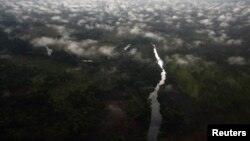LONDON —
Tree loss in the Congo Basin rainforest is slowing down, according to a new study published Monday. The Congo Basin rainforest is the world's second largest, after the Amazon, and scientists say the study is good news for the global environment.
"What we saw is in the 1990s about 285,000 hectares each year removed over Central Africa. And this has declined by over 100,000 hectares in the 2000s. So there was a big drop in deforestation rate in Central Africa between the 1990s and the 2000s, which is quite a surprising result," said Simon Lewis from the University College London.
The study, which is based on analysis of satellite images, shows the deforestation rate in the Congo Basin is lower than in other major tropical forest region in the world.
Lewis said this may in part be because of how Central African countries have developed their economies. They were highly dependent, he said, on oil and mineral wealth, and were investing less in agricultural expansion.
"They are oriented towards those commodities rather than expanding agriculture. So we have not seen the big increase in industrial agriculture like we have seen in the Amazon for soya and in South-east Asia for palm oil. That is not yet happening on a large scale in Central Africa hence these lower deforestation rates," said Lewis.
But he said that could well be changing. He said Central Africa was at a pivotal moment with rising populations, growing demand for food and increased living standards. As these shifts drive demand for commodities from agricultural land deforestation is likely to rise.
"In the Amazon and in Southeast Asia really large areas of what were rainforests have been converted to do this industrial-scale agriculture and there are the first signs that this might be coming to Central Africa," said Lewis.
The study was published in the Philosophical Transactions of the Royal Society B and is part of a series on African forests.
Another study found the trees in the Congo Basin are unique.
Lewis said they were "more grand and more majestic" than had previously been realized.
The experts measured more than 100,000 trees and found that African species are on average much larger than in the Amazon.
British-based Resource Extraction Monitoring director Stuart Wilson has been observing the logging industry in Central Africa for several years. Wilson said they were good for the environment, absorbing carbon dioxide from the atmosphere and so slowing the rate of climate change.
He said Monday's study was good news. But he warned despite logging regulations in many Central African countries, controls were not in place to protect the rain forest. He said governments, and the internatioal community, needed to do more to make sure trees were protected.
"Each of the countries, if it is Congo Brazzaville or Cameroon or Central African Republic, they are all facing massive governance problems. If you take the DRC, for example, the government simply is not present in two-thirds of the country. There is no law enforcement," said Wilson.
The Congo Basin covers more than two million square kilometers.
"What we saw is in the 1990s about 285,000 hectares each year removed over Central Africa. And this has declined by over 100,000 hectares in the 2000s. So there was a big drop in deforestation rate in Central Africa between the 1990s and the 2000s, which is quite a surprising result," said Simon Lewis from the University College London.
The study, which is based on analysis of satellite images, shows the deforestation rate in the Congo Basin is lower than in other major tropical forest region in the world.
Lewis said this may in part be because of how Central African countries have developed their economies. They were highly dependent, he said, on oil and mineral wealth, and were investing less in agricultural expansion.
"They are oriented towards those commodities rather than expanding agriculture. So we have not seen the big increase in industrial agriculture like we have seen in the Amazon for soya and in South-east Asia for palm oil. That is not yet happening on a large scale in Central Africa hence these lower deforestation rates," said Lewis.
But he said that could well be changing. He said Central Africa was at a pivotal moment with rising populations, growing demand for food and increased living standards. As these shifts drive demand for commodities from agricultural land deforestation is likely to rise.
"In the Amazon and in Southeast Asia really large areas of what were rainforests have been converted to do this industrial-scale agriculture and there are the first signs that this might be coming to Central Africa," said Lewis.
The study was published in the Philosophical Transactions of the Royal Society B and is part of a series on African forests.
Another study found the trees in the Congo Basin are unique.
Lewis said they were "more grand and more majestic" than had previously been realized.
The experts measured more than 100,000 trees and found that African species are on average much larger than in the Amazon.
British-based Resource Extraction Monitoring director Stuart Wilson has been observing the logging industry in Central Africa for several years. Wilson said they were good for the environment, absorbing carbon dioxide from the atmosphere and so slowing the rate of climate change.
He said Monday's study was good news. But he warned despite logging regulations in many Central African countries, controls were not in place to protect the rain forest. He said governments, and the internatioal community, needed to do more to make sure trees were protected.
"Each of the countries, if it is Congo Brazzaville or Cameroon or Central African Republic, they are all facing massive governance problems. If you take the DRC, for example, the government simply is not present in two-thirds of the country. There is no law enforcement," said Wilson.
The Congo Basin covers more than two million square kilometers.





